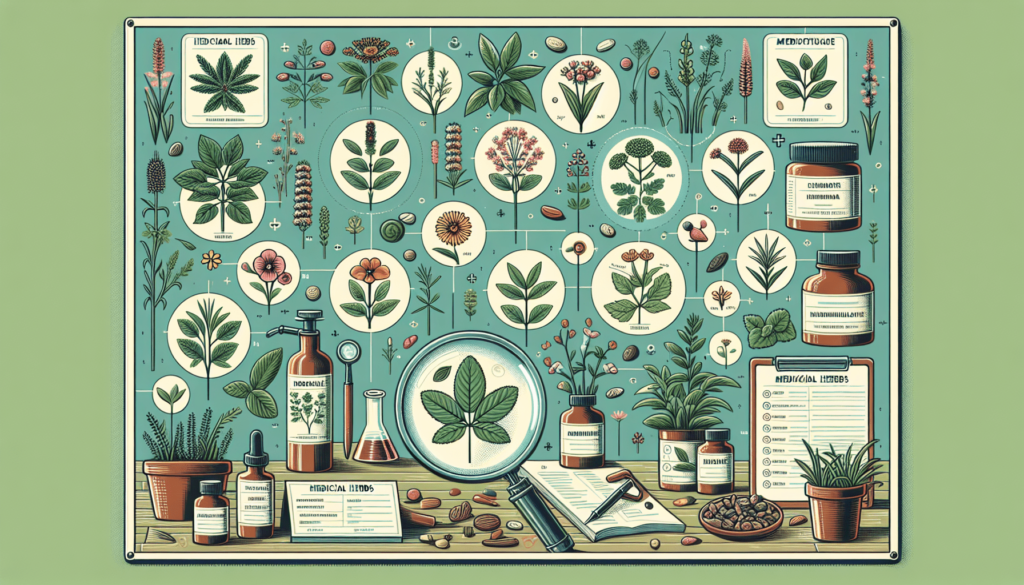So you’ve decided to explore the world of medicinal herbs, but you’re not quite sure where to start. Don’t worry, we’ve got you covered. In this article, we’ll provide you with a beginner’s guide to medicinal herb identification, helping you navigate through the vast array of plants and their healing properties. From understanding the importance of plant identification to learning about common medicinal herbs and their uses, this guide is the perfect jumping-off point for anyone looking to harness the power of nature’s remedies. Whether you have a green thumb or are just curious about the world of herbal medicine, this article will equip you with the knowledge you need to confidently identify and utilize medicinal herbs. So let’s get started!

Understanding Medicinal Herbs
Medicinal herbs play a vital role in natural medicine, providing a holistic approach to health and wellness. Understanding the importance of these herbs can help you harness their benefits in your own life. By using medicinal herbs, you can tap into the healing powers of nature and potentially alleviate various ailments and improve overall well-being.
Importance of Medicinal Herbs
Medicinal herbs have been used for centuries as natural remedies for various health conditions. These herbs contain bioactive compounds that have therapeutic properties, such as anti-inflammatory, antimicrobial, and antioxidant effects. Unlike synthetic drugs, medicinal herbs often have fewer side effects, making them a safe and accessible option for many individuals. Additionally, medicinal herbs promote a more holistic approach to health, addressing not only the physical symptoms but also the underlying causes of illness.
Benefits of Using Medicinal Herbs
Incorporating medicinal herbs into your wellness routine can offer a wide range of benefits. Firstly, these herbs can support the body’s natural healing processes, helping to strengthen the immune system and enhance overall vitality. Medicinal herbs can also alleviate common ailments, such as headaches, digestive issues, and insomnia, without relying on synthetic medications. Furthermore, using medicinal herbs can promote mental well-being by reducing stress, anxiety, and improving cognitive function. By embracing the power of medicinal herbs, you can take charge of your health in a natural and empowering way.
Introduction to Medicinal Herb Identification
Before you can reap the benefits of medicinal herbs, it’s crucial to be able to identify them accurately. Medicinal herb identification involves learning about the characteristics and features of different plants, enabling you to confidently distinguish between various species. Whether you’re exploring wild plants or cultivating a herb garden, understanding how to identify medicinal herbs is essential for safe and effective use.
Getting Started with Medicinal Herb Identification
To begin your journey into medicinal herb identification, there are a few key steps you can take.
Research and Study
Start by researching and studying different medicinal herbs. Familiarize yourself with their common names, scientific names, and the specific health benefits associated with each herb. Understanding their growth habits, favored habitats, and distinctive features will help you identify them in the wild or in a garden setting.
Using Field Guides
Field guides are invaluable resources when it comes to medicinal herb identification. These guides provide detailed descriptions, photographs or illustrations, and identification keys to assist you in recognizing different plant species. Invest in a reputable field guide specific to medicinal herbs to enhance your knowledge and identification skills.
Joining Herb Identification Groups
Consider joining local herb identification groups or online communities where enthusiasts and experts share their knowledge and experiences. Engaging with these communities allows you to learn from others, ask questions, and gain practical insights into identifying medicinal herbs effectively. Collaborating with like-minded individuals is a great way to deepen your understanding and refine your identification skills.
Basic Tools for Medicinal Herb Identification
Equipping yourself with the right tools can greatly aid in the identification process.
Hand Lens
A hand lens, also known as a botanical loupe, is an essential tool for studying the finer details of medicinal plants. With its magnification capabilities, a hand lens allows you to examine the intricate structures of leaves, flowers, and stems. This tool is especially useful when trying to differentiate between similar-looking species.
Botanical Keys
Botanical keys are systematic guides that help identify plant species based on their observable characteristics. These keys typically consist of a series of questions or statements, leading you to the correct identification step by step. By carefully observing and comparing the features of a plant with the options provided in the key, you can identify medicinal herbs accurately.
Field Notebook
Keeping a field notebook is crucial for documenting your observations, especially when exploring new areas or encountering unfamiliar plants. In your notebook, record details such as the plant’s location, date, surrounding environment, and any distinctive features you observe. These notes will serve as a valuable reference for future identification and research.

Key Features to Observe
When identifying medicinal herbs, certain key features deserve your attention. By observing these features, you can differentiate between different species and confidently identify the herbs you encounter.
Plant Size and Growth Habit
Note the overall size and growth habit of the plant. Pay attention to its height, shape, and the arrangement of branches and stems. Some medicinal herbs may grow as sprawling ground covers, while others may have tall, erect stems.
Leaves and Leaf Arrangement
Carefully examine the leaves and their arrangement on the stem. Note the shape, color, texture, and venation patterns of the leaves. Additionally, observe whether the leaves are opposite, alternate, or whorled along the stem. These characteristics can provide valuable clues for identification.
Flowers and Inflorescence
Flowers are often the most visually striking feature of medicinal herbs. Observe the color, shape, and size of the flowers. Pay attention to the arrangement of flowers on the stem or inflorescence. Noting the structure of the flowers, such as the presence of petals, sepals, and stamens, can further assist in accurate identification.
Fruits and Seeds
In some cases, fruits and seeds can provide crucial information for identifying medicinal herbs. Take note of the size, color, and shape of any fruits or seed pods present on the plant. Additionally, observe the structure and arrangement of the seeds within these fruiting bodies. These characteristics can help narrow down the possibilities when identifying herbs.
Identifying Medicinal Herbs by Plant Parts
Certain plant parts carry distinct traits that aid in medicinal herb identification. Focusing on these specific characteristics can help you accurately recognize different species.
Root Identification
For many medicinal herbs, the root system holds vital identification clues. Carefully dig around the base of the plant to expose the roots. Note their color, texture, size, and shape. Some medicinal herb species, such as ginseng, have unique root shapes that are characteristic of their species.
Leaf Characteristics
Leaves are often the first feature people notice when trying to identify a plant. Pay attention to the overall shape, size, and color of the leaves. Examine the leaf edges for any serrations or lobes. Notice any distinct markings, such as veins or hairs on the leaf surface. These leaf characteristics are often key identifiers for different medicinal herbs.
Flower Identification
Flowers are not only visually appealing but can also provide valuable information for identification. Examine the arrangement, size, color, and shape of the flowers. Look closely at the petals, sepals, and stamen arrangement. Be mindful of any distinctive scents emitted by the flowers, as some medicinal herbs have unique fragrance profiles that aid in identification.
Recognizing Medicinal Herb Families
Understanding the concept of plant families can assist in broadening your knowledge of medicinal herbs and their characteristics.
Understanding Plant Families
Plant families consist of groups of related plant species that share common characteristics in terms of their morphology, growth habits, and reproductive features. By studying plant families, you can develop a deeper understanding of the relationships between different medicinal herbs and their shared traits. This knowledge can be a valuable tool for identification, as plants within the same family often share similar features.
Common Medicinal Plant Families
There are several well-known plant families that include numerous medicinal herbs. For example, the mint family, or Lamiaceae, includes popular herbs like mint, basil, and rosemary. The daisy family, or Asteraceae, includes medicinal herbs such as chamomile and echinacea. By becoming familiar with these common medicinal plant families, you can quickly narrow down options when trying to identify a specific herb.
Safety Precautions in Medicinal Herb Identification
While exploring and identifying medicinal herbs, it’s crucial to prioritize your safety and avoid potentially harmful mistakes.
Consulting Experts
If you are unsure about the identification of a medicinal plant or have concerns about its safety, consult with experts. Reach out to experienced herbalists, botanists, or local horticultural organizations for guidance. Their expertise can help ensure accurate identification and reduce the risk of misidentifying toxic plants.
Avoiding Toxic Plant Look-alikes
Some medicinal herbs have toxic counterparts that resemble them closely. It’s essential to be aware of these look-alike plants and learn to distinguish them from the desired medicinal herbs. Particularly when foraging in the wild, be cautious and refer to reliable resources or seek expert advice to avoid dangerous mistakes.
Using Technology for Herb Identification
In today’s digital age, technology can be a valuable tool for medicinal herb identification.
Mobile Apps for Herb Identification
There are numerous mobile applications available that provide comprehensive databases and identification tools for medicinal herbs. These apps often allow you to upload photos, answer specific questions about the plant’s characteristics, and receive accurate identification results. Consider exploring well-reviewed apps that align with your specific medicinal herb identification needs to enhance your knowledge and efficiency.
Online Plant Identification Tools
Online platforms offer a wealth of information and interactive tools to aid in medicinal herb identification. Websites specializing in plant identification often feature extensive databases, clear photographs, and detailed descriptions that can aid in accurate identification. Utilize these resources alongside field guides and other references to expand your identification skills.
Ethical Harvesting of Medicinal Herbs
When collecting medicinal herbs, it is crucial to approach the process ethically and sustainably to ensure the preservation of these valuable resources.
Sustainable Harvesting Practices
Practicing sustainability involves harvesting medicinal herbs in a way that minimizes harm to the plant population and the surrounding ecosystem. Only collect plants that are abundant in your area and leave behind enough individuals for the population to regenerate. Harvest responsibly, ensuring that you do not disturb the surrounding habitat or the plants’ natural growth cycle.
Legal Regulations and Permits
Before harvesting medicinal herbs, educate yourself on the legal regulations and permits governing their collection. Different regions may have specific rules and guidelines to protect vulnerable plant species. Ensure compliance with these regulations to contribute to the conservation of medicinal herbs and maintain ecological balance.
Recording and Documenting Medicinal Herb Identifications
As you delve deeper into medicinal herb identification, it is essential to record and document your findings.
Taking Field Notes
Maintaining detailed field notes is essential for accurate identification and ongoing research. Note the location, date, and time of your herb identification excursions. Record any visible features, observations, or interactions with the plant. These notes will serve as a valuable reference for future research, comparison, and further study.
Organizing Plant Pressings and Specimens
Pressing and preserving plant specimens is an excellent way to create a physical record of your medicinal herb identifications. Follow proper techniques for pressing plants to retain their color and structure effectively. This allows you to build a personal herbarium or contribute to existing botanical collections. Organize these specimens carefully, labeling them with relevant information to enhance their value for future reference.
As you begin your journey into medicinal herb identification, remember that patience, practice, and continuous learning are key. Develop a keen eye for detail, lean on available resources, and consult with experts when needed. With time, you will build a solid foundation of knowledge and skills that will allow you to confidently navigate the world of medicinal herbs and unlock their countless benefits. Happy herb identification!

